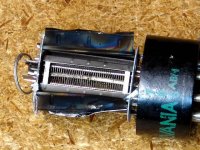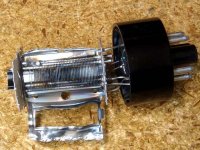Those who follow my (sometimes excessive) experiments know that I have found myself up against the limitations of my old Fluke 407D power supply. There have been several experiments where I could not find the "maximum power output" or "turn it up till it explodes". I had 4 days off of work (rare lately) and I had to take the customary trip to my mom's for Thanksgiving. Sherri wanted to visit a friend in Orlando for some of the extreme retail stupidity that occurs on "Black Friday" so off we went. I had no desire to hit the mall, so I visited my old high school friend who is in the surplus business, and there it was. A HP 6448B power supply. 0 to 600 volts at 1.5 AMPS! I had visions of brightly glowing melted tubes, so a deal was struck.
I got home last night and I was sure that the power supply was hungry since it had been sitting outside in the Florida rain for several months in a scrapyard. I decided to feed it and test it at the same time. How quickly could it "eat" one of those gassy 6V6's that I had. Well I guess that it wasn't so hungry after all since it chewed on that 6V6 for 15 minutes until the bench breaker blew. The light show and fireworks display was awesome but I had accidentally hit the manual focus button on my camera so there no pictures of the action.
The photo shows the meaning of "excessive grid current". Note the warping of the cathode rod.
I got home last night and I was sure that the power supply was hungry since it had been sitting outside in the Florida rain for several months in a scrapyard. I decided to feed it and test it at the same time. How quickly could it "eat" one of those gassy 6V6's that I had. Well I guess that it wasn't so hungry after all since it chewed on that 6V6 for 15 minutes until the bench breaker blew. The light show and fireworks display was awesome but I had accidentally hit the manual focus button on my camera so there no pictures of the action.
The photo shows the meaning of "excessive grid current". Note the warping of the cathode rod.
Attachments
I was about to turn the bench off when I remembered the box of bad tubes that I got from the AES tube sale. Would my new power supply like the taste of a vintage GE 6BQ6GA with a little gas? You know it. Same deal as before, the fun ended when the bench breaker blew. It blew because the tube failed to a dead short. I have never seen that happen before.
OK, autopsy revealed the cause of the dead short. The screen grid support rod had melted and touched the beam plate. Now that is some excessive screen dissipation.
All this fun is over now, but this power supply will be used to design some big amps in the future. I must revisit my cathode follower, hybrid amp, and screen drive experiments since all of them were limited by lack of power. None of this will happen until early next year due to work and travel commitments.
OK, autopsy revealed the cause of the dead short. The screen grid support rod had melted and touched the beam plate. Now that is some excessive screen dissipation.
All this fun is over now, but this power supply will be used to design some big amps in the future. I must revisit my cathode follower, hybrid amp, and screen drive experiments since all of them were limited by lack of power. None of this will happen until early next year due to work and travel commitments.
Attachments
George, you have too much fun!..........
Like me back in Tech school playing with an old B&W TV, ran a 12 Gauge to ground & playing with an arc off the HV....the screen would shrink with the "load".
Makes you think if one could use ultra high temp internals for screen, anode, cathode components....what was that material? Iconel X????
___________________________________Rick............
Like me back in Tech school playing with an old B&W TV, ran a 12 Gauge to ground & playing with an arc off the HV....the screen would shrink with the "load".
Makes you think if one could use ultra high temp internals for screen, anode, cathode components....what was that material? Iconel X????
___________________________________Rick............
let's see you bring a 750TL to its knees
Sorry, only otherwise worthless tubes are accepted into my "testing program". I have a fair quantity of 833A's that are going to "meet the power supplies". Don't worry, a current limited power supply can be used to safely test and measure large tubes like these. I plan to stash away a few good ones for myself, and sell the extra good ones on Ebay. Now if I find a bad tube that still conducts current............
No vid
I have attempted to take video of some of my "experiments" but so far have not been successful. Things just don't blow up when they are being watched. I tested out one of my other power supply acquisitions on a similar gassy 6V6. I have 20 minutes of video of it quietly glowing bright blue with no fireworks. Cathode current was at the 200 mA limit of the power supply. Sooner or later I will catch one.
No picture of the monster?
I didn't think it was needed. It looks like any other generic HP (or Agilent) large power supply. Rack mount, 6 inches high, beige face with two analog meters and two knobs. It weighs about 40 pounds.
It is from the first generation of "SMPS's" that are basically glorified light dimmers on the primary of a conventional 60Hz power transformer. The "switching frequency" is 60 Hz so the loop dynamics are slow, very slow. There is a current limiter, but it is very slow to react. A short across the output will cause a serious peak current (tens of amps) to flow until the current limiter kicks in. Voltage overshoots are a common occurrence.
The 6V6 shown in the photo was actually the third one I hooked up. The first one made a loud bang when I turned up the voltage, even though I had the current knob all the way down. One of the leads inside the base had blown in half. The second one vaporised the little cathode strap inside the tube when it arced. I used a "ballast resistor" (8 ohms 500 W) for the two tubes shown above.
This type of power supply was common in the late 70's and early 80's. You must understand how they work and their limitations when using them. I used to have a large Sorrensen power supply on my desk at work. Something like 0 to 80 volts at 20 or 30 amps. I watched a guy hook up an expensive ham radio to it. I explained that the supply would blow up his radio, but the "expert" replied that he "knew what he was doing". He keyed the radio and tuned on it for a while, bragging about getting 150 watts out of his 100 watt radio. When he finally released the PTT the power supply was instantly unloaded and the voltage shot up to 30 or 40 volts toasting his radio.
These power supplies can misbehave when loaded with a class AB or worse a near class B screen drive amp. I will be finding out how badly it behaves in the comming months as I hook up exaxtly this type of load.
- Status
- This old topic is closed. If you want to reopen this topic, contact a moderator using the "Report Post" button.
- Home
- Amplifiers
- Tubes / Valves
- WMD or Big Freakin Power Supply



